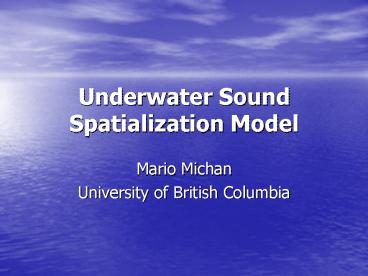Underwater Sound Spatialization Model - PowerPoint PPT Presentation
1 / 13
Title:
Underwater Sound Spatialization Model
Description:
Sound propagate through the bones directly into the inner ear (Cochlea) ... Measure the response of the system at the Cochlea. CAD Model. Sound Source. Sound Source ... – PowerPoint PPT presentation
Number of Views:58
Avg rating:3.0/5.0
Title: Underwater Sound Spatialization Model
1
Underwater Sound Spatialization Model
- Mario Michan
- University of British Columbia
2
Outline
- Sound Physics and Psychoacoustics
- Spatial Audio Systems and HRTF
- Underwater Sound and Spatialization
- Bone Conduction and STF
- Model and Results
3
Physics of Sound
- Sound are pressure waves (propagate)
- Longitudinal and Transverse (shear stresses)
- Can be modeled using the Helmholtz equation for
sound pressure in aqueous mediums and as a
harmonic stress in solid mediums - We can model the propagation by coupling the
equations - We can assume the mediums are linear and apply
Fourier Analysis and the Convolution Theorem
4
PsychoacousticsSpatialization of Sound
- Auditory system ability to localize sound
- Leads to Echolocation applications
- Main cues
- ITD
- ILD
- Pinna Notch
- Reverberation and echo
- HRIR HRTF
- Different for each individual (need PCA or
something similar) - We use the LISTEN database of 51 subjects
5
Underwater Sound
- Very poor ability to localize sound underwater
- Impedance match with head (ILD)
- Faster speed of sound 5X air speed (ITD)
- Attenuation of Higher Freq and lower threshold of
hearing (Pinna notch) - Middle ear blockage by air water interface
- No natural echolocation possible since HRTF
doesnt work
6
Bone Conduction
- Sound propagate through the bones directly into
the inner ear (Cochlea) - Efficient way to transmit sound underwater
- We could convey sound spatialization information
this way using the HRTF - But sound get modified through the bones
- So we need the Skull Transfer Function
- How do we calculate the STF and ISTF?
- We model it using the equations of sound and a
differential equation numerical solver (Finite
Element Analysis)
7
Model
- Model the sound propagation through the skull
using a CAD model of the skull - Couple the stress model with the acoustic model
- Measure the response of the system at the Cochlea
8
CAD Model
Water Sphere
Simplify
Sound Source
Sound Source
9
(No Transcript)
10
Solid Medium (Deformation)
11
Acoustic Medium (SPL)
12
STF and Modified TF
13
Experiments
- Two experiments
- Above water air
- Underwater
- Results STF showed marginal improvement over
simple HRTF - Causes very simple model need more computational
power - However, very good correlation of above and
underwater experiments good tool - Also it is possible to spatialize sound
underwater!!!































